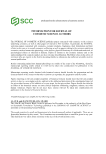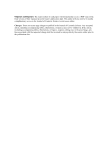Takahashi
et
al.
–
2001
Double-blind clinical study
Malus
pumila
29
4
months
Human
Male
pattern baldness
1.8
mL
of procyanidin
B-2
applied
twice
daily
to
the subjects’
affected
area
of
the
head.
n/a
n/a
Placebo
(vehicle)
Increased
ratio
of
hairs
measuring
more
that
40
um
in
diameter
(p
0.05) increased
mean
value
of
hair diameter
(p
0.002) increase
in number
of
total
hairs
in
the designated
scalp
area
(p
0.001)
increased
hair
density
over baseline
(p
0.002)
Proanthocyanidins,
including procyanidin
B-2,
may
stimulate
anagen
induction
to
allow
for growthpromoting
activity.
None
Takahashi
et
al.
–
2005
Double-blind clinical study
Malus
pumila
43
12
monthsHuman
Male
pattern baldness
Topical
application
of
0.7% procyanidin oligmers
on affected
scalp
twice
a
day
n/a
Procyanidin Oligomers:
7.3%
(w/w)
procyanidin
B-1,
26.2%
(w/w) procyanidin
B-2,
and
7.7%
(w/w) procyanidin
C-1
Placebo
(vehicle)
Greater
incresase
in
total
number
of
hairs
on
affected
area
in comparison
to
control.
Increase
in
total
number
of
hairs
within treatment
group
compared
to baseline.
Procyanidin
might
play
role
in
TGF-b
pathway
which
deals
with
lipid
peroxidation
and
inflammation,
both
of
which
are
known
to aggravate
male
pattern
baldness.
None
et
al.
–
2001
Double-blind clinical study
Malus
pumila
29
4
months
Human
Male
pattern baldness
1.8
mL
of procyanidin
B-2
applied
twice
daily
to
the subjects’
affected
area
of
the
head.
n/a
n/a
Placebo
(vehicle)
Increased
ratio
of
hairs
measuring
more
that
40
um
in
diameter
(p
0.05) increased
mean
value
of
hair diameter
(p
0.002) increase
in number
of
total
hairs
in
the designated
scalp
area
(p
0.001)
increased
hair
density
over baseline
(p
0.002)
Proanthocyanidins,
including procyanidin
B-2,
may
stimulate
anagen
induction
to
allow
for growthpromoting
activity.
None
Takahashi
et
al.
–
2005
Double-blind clinical study
Malus
pumila
43
12
monthsHuman
Male
pattern baldness
Topical
application
of
0.7% procyanidin oligmers
on affected
scalp
twice
a
day
n/a
Procyanidin Oligomers:
7.3%
(w/w)
procyanidin
B-1,
26.2%
(w/w) procyanidin
B-2,
and
7.7%
(w/w) procyanidin
C-1
Placebo
(vehicle)
Greater
incresase
in
total
number
of
hairs
on
affected
area
in comparison
to
control.
Increase
in
total
number
of
hairs
within treatment
group
compared
to baseline.
Procyanidin
might
play
role
in
TGF-b
pathway
which
deals
with
lipid
peroxidation
and
inflammation,
both
of
which
are
known
to aggravate
male
pattern
baldness.
None








































































